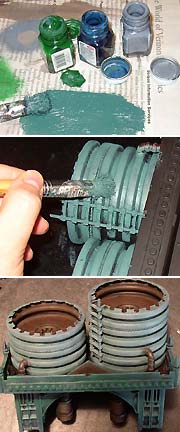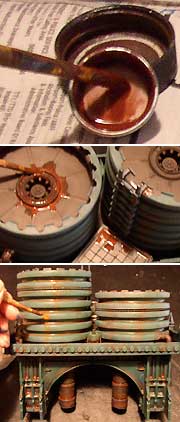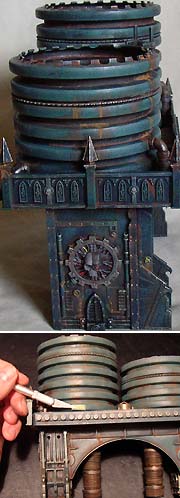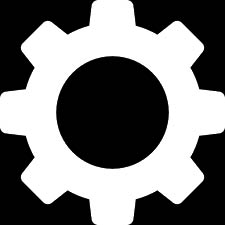
Drybrush the tanks in a nice distinctive color. I mixed up a custom Teal blue color for mine, using green, blue and grey. Then use a lighter drybrush pass with light grey for highlights.
Drybrush the tops and insides of the tanks, and all the pipes, with dark brown.
Drybrush the rest of the tower in a darker color. I used dark blue-green for mine. Highlight with a lighter pass of drybrushing using light grey.

Anyway, I like to use a rust color for the main wash, working from the top down and brushing streaks down the sides here and there. Be sure to hit the pipes and rivets heavily. Using care, you can control your streaks with a fingertip or gentle blowing. Next, switch to a light brown and hit the same areas again, but more sparingly this time. As a guide, rust can range from near-black to bright orange- dark rust is old rust, light rust is the most fresh.

Metallics are also great for highlighting rivets. Gently drybrush over the rivets, holding the brush at an angle so it doesn't smear paint onto the surface below the rivets.
Now you can get in there with a fine brush and paint any details like
cables, gauges and skulls in contrasting colors like red, yellow and white.
Finally, add decals as you see fit. I have a fondness for the stickers from Zoids model kits, as they are easy to apply, durable, and suitably techy looking. When applying stickers, affix an edge of the sticker to the side of a hobby knife- this makes positioning a lot easier. If you have to rip the sticker off, it might take some paint with it!
Once your decals and / or stickers are affixed and dry, coat them with a matte finish / flat coat to take any shine off. Mixing a tiny bit of dark brown into the flat coat will help darken down the graphics to better match your grimy paint job!
 STC WATER TOWER
STC WATER TOWER